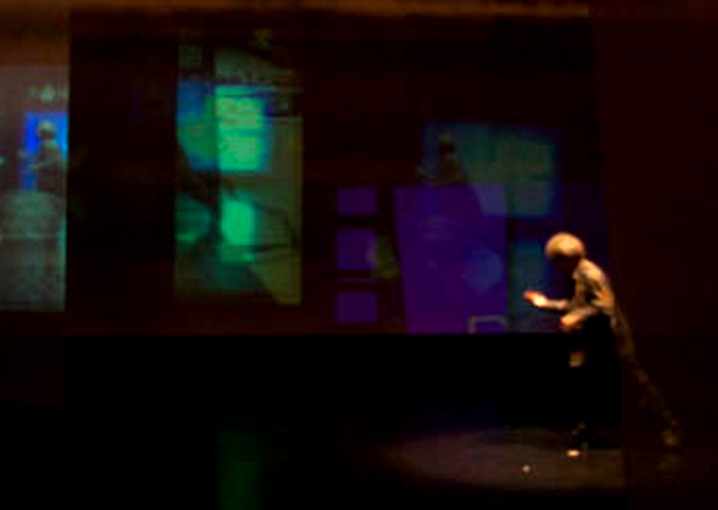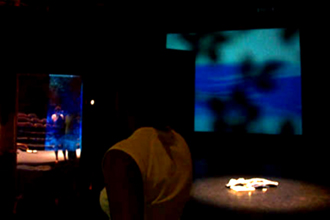Menu
Word/Phrase Index
SDAT04 Home
Documentation Introduction
Seminars
Schedule
Compositional Questions and Approaches
A list of some questions regarding compositional approaches to using technology.
Questions and Answers:Question #1: Just because you can; should you?
Answer #1: No. The technology used should be integral to the work. It needs to be integrated into the thematic fabric of the performance or installation. This make the use of technology purposeful, meaningful as opposed to a gimmick to dazzle. (Apryl Seech)
Answer #2:If you can do something performative with technology that is informative or reflective of the way we live today or directions in which we are evolving culturally or creatively, yes...by all means. We owe it to ourselves to keep creating exciting new work and realizing that along the way that each effort may not be a great production, performance, art or stellar piece of technology...but the sum of our efforts moving towards a synthesis of art and media is truly something worthwhile in ways we are only able to sense, but perhaps not fully comprehend. Personally, I find some works involving technology and cyborg-bodies ethically challenging and dislike body-invasive art or abandonment of the observable reality for the theoretical. The virtual and visceral are in dialogue to some extent in any piece which contains both human creativity or hand in creation and technology.(Nadja Masura)
Answer #3: No. The technology used should be integral to the work. It needs to be integrated into the thematic fabric of the performance or installation. This make the use of technology purposeful, meaningful as opposed to a gimmick to dazzle.(Apryl Seech)
Question #2: Just because you did; do we have to see it?
Answer #1: I take this question as does the audience
have know the technology is being use. Personally I am torn on this particular
issue. If the technology is integrated into the fabric of a performance
or installation then it would seem that exposing would only highlight
the technology over the actual piece. A piece I created last year used
motion sensing technology. I choose to not say anything about the technology.
In my opinion, trigger audio score augmented the atmosphere of the overall
piece. To me to bring the technology to the audience’s attention
would have accentuated the importance of the technology over the meaning
of the piece. However, after the performance, I learned that the audience
really wanted to know. Audience members felt that it would have assisted
them in understanding the work.
I believe there are other reasons for exposing the technology. New media
can be very transparent, almost invisible. That discovering ways to reveal
it to the audience is in a sense a political act, awakening the viewers’
awareness of media’s transparency. Yes there can be a purpose to
exposing or letting the audience “see it.” (Apryl Seech)
Answer #2: But of course the audience is not forced to attend. Often it seems as if the artist/technologist must cope with fluctuating levels of interest (and perhaps understanding) from an audience which either expects or desires a traditional piece rather than a hybrid, or is hooked on flash and hype....which can lead to works which emphasize technology as medium and message rather than works which parallel creative thought and media content. The former often creates an aesthetic which can become predictably disjuncture, dark and futuristic. However, when these creative thought and technology are married, we can transcend expectations for human creativity. (Nadja Masura)
Question #18: Write about a few of the compositional strategies you are using either as a choreographer or as a media/technical artist. Are there differences between analog and digital strategies?
Answer #1: I think in most art mediums there are universal principals of design that, once converted to fit the appropriate medium, are interchangeable. I think the most common element across the board is based on qualitative means and scaling. Are the motions big or small, delicate or stern, is the media quiet or striking, up close or not. These are parallel questions I feel that are most important when questioning composition strategies in such D&T endeavors.(Ricky Alvarez)
Question #21: Where do you see the issues of content and form evolving within the context of the workshop – specifically ideas of media as mirror/constructing self, the concept of the cyborg, issues of remote presence, and the use of navigable structures/invisible space?
Answer #1: I think in any learning process that there are always high or ambitious expectations in achieving a successful end product when entering a new medium. Yet, before one can fun a 5k marathon one must first learn how to walk. With that said, within the context of the workshop I felt that steadily we began to work towards a more cohesive end product once we gained more knowledge and experience with the media, movement, and workspace. Breaking through any preliminary anxiety or skepticism I felt our efforts began to evolve in a more mature and complex direction, which I feel once again is natural in any learning process. Considering how diverse of a group we were, especially in our backgrounds and computer literacy, I felt the mix contributed to some sound discussions and firm grounding within the classroom.Specifically though, focusing on provocative questions on such things are media as mirror, constructing self, the concept of cyborg's, issues of remote presence, and the use of navigable structures and invisible space (all topics presented in the workshop) I fell provided an excellent spring board to launch into theoretical discussions and investigative probing. Although the majority of our time was focused on learning, the moments we were given (daily opportunities) to execute creative attempts and investigate these topics were first challenging since the information was so new, but beneficial without a doubt. These attempts exercised our abilities to implement our introductory knowledge in Max/MSP or in 3D modeling, developed an awareness of staging technological devices, informed us of technical limitations and opportunities, and overall exercised our creative minds in the whole directing and implementation of a full production in dance in technology which is not always easily achieved in our home facilities. Though as mentioned before, with 10 days concentrated in learning the creative exercise we pursued, I thought, served as rough sketches of would could later develop into a more solid conceptual idea. (Ricky Alvarez)
Images

Afternoon Work Session

Afternoon Work Session
